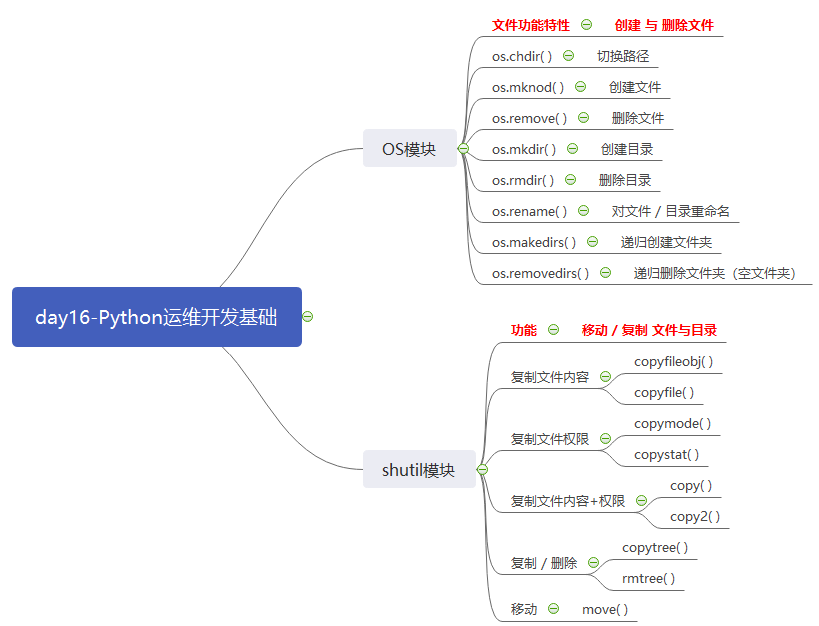1. OS模块与shutil模块
os :新建/删除
shutil: 复制/移动


# ### os模块 与 shutil模块 """ os 新建/删除 shutil 复制/移动 """ import os os.chdir("/home/wangwen/mywork") #os.mknod 创建文件 # os.mknod("ceshi111.txt") #os.remove 删除文件 # os.remove("ceshi111.txt") #os.mkdir 创建目录(文件夹) # os.mkdir("ceshi200") #os.rmdir 删除目录(文件夹) # os.rmdir("ceshi200") #os.rename 对文件,目录重命名 # os.rename("ceshi100","ceshi1001") #os.makedirs 递归创建文件夹 # os.makedirs("a/b/c/d/e/f") #os.removedirs 递归删除文件夹(空文件夹) # os.removedirs("a/b/c/d/e/f") # ### shutil import shutil # 1. 单纯仅仅复制文件内容 #copyfileobj(fsrc, fdst[, length=16*1024]) 复制文件 (length的单位是字符(在r模式下,read单位是字符个数,在rb模式read单位是字节个数)) # fp1 = open("ceshi100.py",mode="r",encoding="utf-8") # fp2 = open("ceshi101.py",mode="w",encoding="utf-8") # shutil.copyfileobj(fp1,fp2) #copyfile(src,dst) #单纯的仅复制文件内容 , 底层调用了 copyfileobj # shutil.copyfile("ceshi101.py","ceshi102.py") # 2. 单纯仅仅复制文件权限 #copymode(src,dst) #单纯的仅复制文件权限 , 不包括内容 (虚拟机共享目录都是默认777) # shutil.copymode("ceshi102.py","103.py") #copystat(src,dst) #复制所有状态信息,包括权限,修改时间等,不包括内容 # shutil.copystat("ceshi102.py","104.py") # 3. 文件内容 + 文件权限 #copy(src,dst) #复制文件权限和内容 # shutil.copy("ceshi102.py","105.py") #copy2(src,dst) #复制文件权限和内容,还包括权限,时间等 # shutil.copy2("ceshi102.py","106.py") # 4.复制 / 删除 #copytree(src,dst) #拷贝文件夹里所有内容(递归拷贝) # shutil.copytree("ceshi1001","ceshi1002") #rmtree(path) #删除当前文件夹及其中所有内容(递归删除) # shutil.rmtree("ceshi1002") # 5.移动 move(path1,paht2) #移动文件或者文件夹 # 移动文件夹 # shutil.move("ceshi1001","../ceshi1003") # 移动文件 shutil.move("104.py","../111.py")
2. os.path 模块


# ### os.path import os strvar = "/home/wangwen/mywork/ceshi1.py" #basename() 返回文件名部分 res = os.path.basename(strvar) print(res) #dirname() 返回路径部分 res = os.path.dirname(strvar) print(res) #split() 将路径拆分成单独的文件部分和路径部分 组合成一个元组 res = os.path.split(strvar) print(res) #join() 将多个路径和文件组成新的路径 可以自动通过不同的系统加不同的斜杠 linux / windows path1 = "home" path2 = "wangwen" path3 = "mywork" # 方法一 pathvar = path1 + os.sep + path2 + os.sep + path3 print(pathvar) # 方法二 pathvar = os.path.join(path1,path2,path3) print(pathvar) # d:homewangwenmywork # D:gongxiang8day16 # /home/wangwen/mywork/ #splitext() 将路径分割为后缀和其他部分 (了解) strvar = "/home/wangwen/mywork/ceshi1.py" res = os.path.splitext(strvar) print(res) # 用字符串中的split也可以分割出后缀部分 a,b = strvar.split(".") print(a,b) #getsize() 获取文件的大小 res = os.path.getsize("1.py") print(res) # ### isdir / isfile / islink #isdir() 检测路径是否是一个文件夹 res = os.path.isdir("ceshi100") print(res) #isfile() 检测路径是否是一个文件 res = os.path.isfile("1.py") print(res) #islink() 检测路径数否是一个链接 res = os.path.islink("/home/wangwen/ceshi200/ceshi100") print(res) # ### getctime / getmtime / getatime #getctime() [windows]文件的创建时间,[linux]权限的改动时间(返回时间戳) pathvar = "/home/wangwen/mywork/103.py" res = os.path.getctime(pathvar) print(res) import time str_time = time.ctime(res) print(str_time) #getmtime() 获取文件最后一次修改时间(返回时间戳) res = os.path.getmtime(pathvar) print(res) import time str_time = time.ctime(res) print(str_time) #getatime() 获取文件最后一次访问时间(返回时间戳) res = os.path.getatime(pathvar) print(res) import time str_time = time.ctime(res) print(str_time) #exists() 检测指定的路径是否存在 pathvar = "/home/wangwen/mywork/10323223.py" res = os.path.exists(pathvar) print(res) #isabs() 检测一个路径是否是绝对路径 pathvar = "." res = os.path.isabs(pathvar) print(res) #abspath() 将相对路径转化为绝对路径 res = os.path.abspath(pathvar) print(res) # 结合使用 if not os.path.isabs(pathvar): pathnew = os.path.abspath(pathvar) print(pathnew)

# ### 如何计算一个文件夹中所有文件的大小 import os pathvar = "/mnt/hgfs/gongxiang8/day16/ceshi100" # (1)获取文件夹中所有的文件名称 lst = os.listdir(pathvar) print(lst) """ 拼接路径,计算文件大小 res = os.path.join(pathvar,"1.txt") print(res) # "/mnt/hgfs/gongxiang8/day16/ceshi100/1.txt" res2 = os.path.getsize(res) print(res2) """ # (2)计算所有文件的大小 [缺陷:不能计算文件夹中的内容] size = 0 for i in lst: pathnew = os.path.join(pathvar,i) # 判断是否是文件 if os.path.isfile(pathnew): print(i,"[是文件]") size += os.path.getsize(pathnew) # 判断是否是文件夹 elif os.path.isdir(pathnew): print(i,"[是文件夹]") # (3)使用递归计算文件夹中所有文件大小 def getallsize(pathvar): size = 0 lst = os.listdir(pathvar) for i in lst: # 路径 + 文件名 => 绝对路径 pathnew = os.path.join(pathvar,i) if os.path.isfile(pathnew): # 计算文件大小 size += os.path.getsize(pathnew) elif os.path.isdir(pathnew): size += getallsize(pathnew) return size res = getallsize(pathvar) print(res)
3. tarfile 压缩模块


# ### tarfile 压缩模块 后缀为.tar | .tar.gz | .tar.bz2 import tarfile # ### 1.创建tar压缩包 [官方: 理论上可以压缩到最小的模式是bz2] # (1) 创建压缩包 """.tar的压缩包,只打包不压缩 276480""" tf = tarfile.open("ceshi1029.tar","w",encoding="utf-8") # (2) 写入文件到压缩包中 tf.add("/bin/ntfscmp","ntfscmp") tf.add("/bin/openvt","openvt") tf.add("/bin/grep","tmp/grep") # (3) 关闭压缩包 tf.close() # 2.创建.tar.gz压缩包 120462 tf = tarfile.open("ceshi1030.tar.gz","w:gz",encoding="utf-8") tf.add("/bin/ntfscmp","ntfscmp") tf.add("/bin/openvt","openvt") tf.add("/bin/grep","tmp/grep") tf.close() # 3.创建.tar.bz2压缩包 115728 tf = tarfile.open("ceshi1031.tar.bz2","w:bz2",encoding="utf-8") tf.add("/bin/ntfscmp","ntfscmp") tf.add("/bin/openvt","openvt") tf.add("/bin/grep","tmp/grep") tf.close() # ### 2.解压压缩包 tf = tarfile.open("ceshi1030.tar.gz","r",encoding="utf-8") # extract(文件,路径) # tf.extract("ntfscmp","ceshi1030") # extractall(路径) tf.extractall("ceshi1030") tf.close() # ### 3.追加文件 支持with语法 with tarfile.open("ceshi1029.tar","a",encoding="utf-8") as tf : tf.add("/bin/gzip","gzip") # error tarfile中的追加,只能是对只打包不压缩的包进行追加,其他的模式不可以; """ with tarfile.open("ceshi1031.tar.bz2","a",encoding="utf-8") as tf: tf.add("/bin/gzip","gzip") """ # ### 4.查看压缩包中的内容 with tarfile.open("ceshi1029.tar","r",encoding="utf-8") as tf : lst = tf.getnames() print(lst) # ### 如何解决tarfile中存在的缺陷?(不能追加文件到已经压缩的包) """ (1) 先解压所有文件到文件夹 (2) 把想要追加的内容复制到文件夹中 (3) 经过过滤筛选,重新打包压缩 """ import os # 获取当前脚本所在的路径 pathvar = os.getcwd() # print(res) # /mnt/hgfs/gongxiang8/day16 # 压缩包路径 path1 = os.path.join(pathvar,"ceshi1031.tar.bz2") print(path1) # 解压的路径 path2 = os.path.join(pathvar,"ceshi1031") # (1) 先解压所有文件到文件夹 with tarfile.open( path1 , "r",encoding="utf-8") as tf: tf.extractall(path2) # (2) 把想要追加的内容复制到文件夹中 mybin = "cp -a /bin/ip " + path2 # cp -a /bin/ip /mnt/hgfs/gongxiang8/day16/ceshi1031 os.system(mybin) # (3) 经过过滤筛选,重新打包压缩 lst = os.listdir(path2) print(lst) with tarfile.open(path1,"w:bz2",encoding="utf-8") as tf: for i in lst: if i != "openvt": # 拼接绝对路径 pathnew = os.path.join(path2,i) # add(路径,别名) tf.add(pathnew,i)
day16
